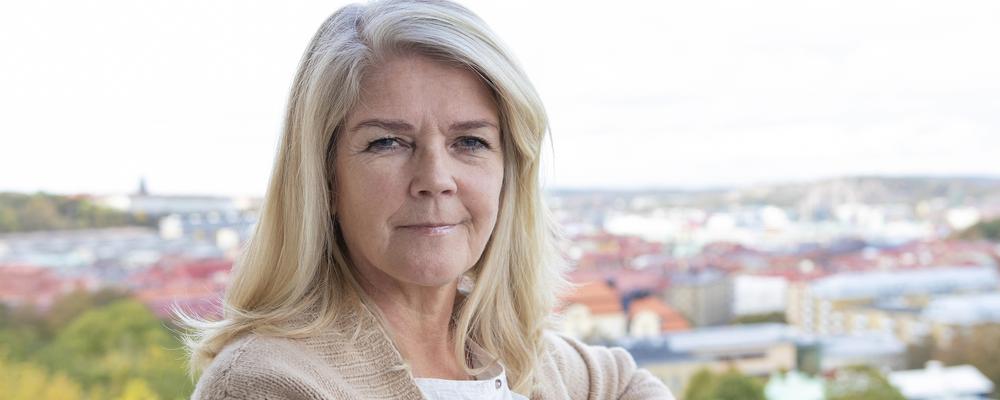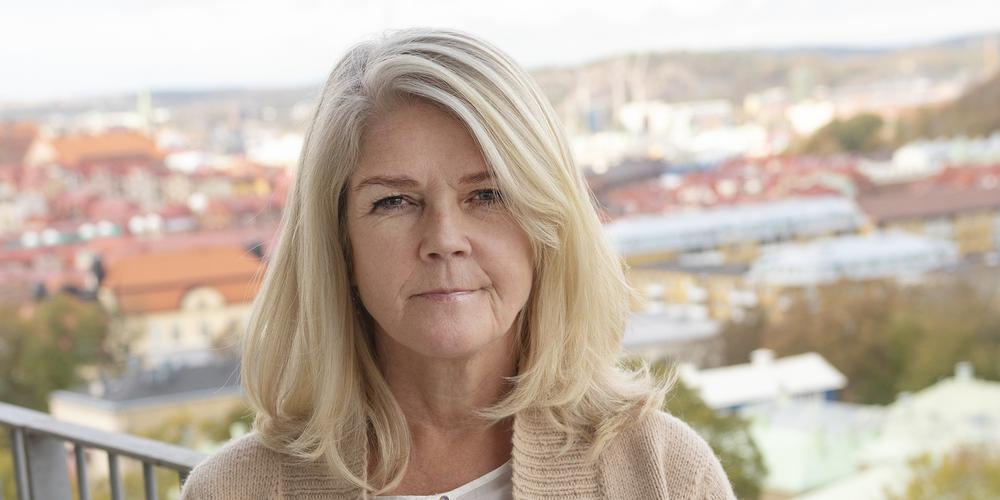
- Home
- Research
- Find research
- New professor of register research
New professor of register research
Soffia Gudbjörnsdottir not only heads a globally unique platform for diabetes research. She has also visited all of Sweden’s 21 counties in her quest for better diabetes care. Here, she talks about the main theme in her work, how she hopes register-based research will develop, and why homesickness is her constant companion.
Soffia Gudbjörnsdottir is pleased with her new professorship at the University of Gothenburg, not for her own sake alone but for that of all register-based research. She hopes her new position will help to strengthen and stimulate the whole field and generate new interfaces between researchers and registers.
“I’m hoping for greater collaboration involving various registers, and more researchers using them, but also for researchers in new fields to come into contact with the registers. Sweden offers incredible opportunities. It’s wonderful being able to link data from different registers down to personal ID number level, and derive unique databases that can generate new knowledge.”
Mission impossible
In 1999, Gudbjörnsdottir was invited to be Registrar (Director) of the Swedish National Diabetes Register (NDR). The NDR, which was initiated by the profession, had then existed for four years and was still under development. There were paper forms to fill in, patchy coverage, and delayed reporting.
“It was something of a mission impossible. The primary care services, which look after the majority of diabetes patients, had doubts. They didn’t really see the benefit of the extra workload. And the quality registers were severely underfunded, so it was hard to get started,” she says.
However, right from the start, Gudbjörnsdottir loved her job and embarked on finding a way to create the NDR online with the primary care services on side. Today, basically all diabetic patients in Sweden are entered in the NDR, which is now managed entirely digitally in a system with over 1,400 users. Seventy percent of all data is transferred directly from patients’ records.
“That number’s risen gradually. Since there are so many systems of medical records in Sweden, we’ve had to tackle them one at a time. The others have to log in and report their own data,” she says.
Important part of health care
Today, the NDR is a natural part of Swedish diabetes care, just as quality registers are in care of patients with many other kinds of ill-health, from cardiac diseases to psychiatric disorders. People with diabetes can also log in to see their own data and how their clinic is performing compared with others.
“Our mission’s very simple: to make the care services better. By helping to raise standards of care and make it more equal for all, the Register has been a powerful tool for improvement. Now we’ve also got such large volumes that we can do good observational studies and describe risk factors and their control, excess morbidity and excess mortality, and see their trends over time,” Gudbjörnsdottir says.
She makes a point of emphasizing that both register management and register-based research entail teamwork. The NDR has three research nurses involved in register development, working in care facilities, receiving feedback, and operating a helpdesk. They also have one data manager and two statisticians whose appointments became possible as the funding improved, and with the advent of the Centre of Registers, where more quality registers are assembled.
“I’m so proud of the team we’ve created and the fantastic people it’s my pleasure to work with. It’s a real team effort. We work closely with both primary care services and hospitals. I think I’ve been to every county in Sweden at least once. We also work with the patient associations to sound out their views and what’s important to the patients.”
Good project coordinator
The NDR is used not only to develop health care but as a world-leading platform for both Swedish and international research. Ten PhD students are currently engaged in NDR-based projects, and many national and international collaborations are under way.
Gudbjörnsdottir used to work as a doctor specializing in diabetes at Sahlgrenska University Hospital, but for the past few years she has been employed full-time as a researcher and national registrar. The latter role means that she is primarily responsible for developing the NDR and coordinating activities.
“You could call me the spider in the web. To me, it’s thrilling to start projects and bring people together. That’s probably my greatest strength as a researcher, believing in the projects and doing the coordination. And then I’ve had outstanding luck with my PhD students.”
Gudbjörnsdottir works at the Centre of Registers Västra Götaland, which has premises at Medicinaregatan 18G. Some 20 national quality registers are managed and developed there. From her bright office, high up in the building, Linnéplatsen (“Linnaeus Square”) may be seen across a patch of forest. The balcony at the end of the corridor offers a panoramic view of Linnéstaden, Masthugget, Lindholmen, and Ramberget.
Panoramic views

Here, with panoramic views of both her surroundings and her subject, Gudbjörnsdottir might be described as having arrived in her element. She began her career as a clinical researcher, with a thesis on how insulin resistance, hypertension, and the sympathetic nervous system are connected.
“But subjecting healthy people to all that testing didn’t come easily to me. Switching to register research and looking at the numbers instead suited me better.”
What her research projects have in common is use of the NDR, in particular, but their subject range has been wide. She has described the disease and its trends over time, and found associations among risk factors, mortality, and late complications. She has also investigated such subjects as the effects of various treatments; how to optimize control of risk factors like blood glucose, blood pressure, and lipids; prediction of cancer and cardiovascular disease in diabetes; and outcomes of bariatric surgery in type 2 diabetes.
Diabetes care is constantly evolving, in terms of technical aids and new drugs alike. Gudbjörnsdottir’s research has also confirmed that much is going in the right direction. Both morbidity and mortality are falling considerably. However, compared with people who do not have diabetes, excess mortality persists.
When I ask her what it takes to become a good register scientist she replies, after a moment’s pause for thought, “Accuracy and patience.” They are also two characteristics she herself exudes, with her thoughtful way of speaking and her beautiful Icelandic accent.
Chronic homesickness
Gudbjörnsdottir grew up outside Reykjavik. It was somewhat by chance that she became a doctor. Her elder brother studied medicine and this enabled her to do the same. In 1988, she and her Icelandic husband — both newly qualified doctors — moved to Sweden. They planned to train as consultant physicians at Sahlgrenska University Hospital and then return home.
“That was 30 years ago, and we’re still here. But my homesickness is almost constant and it grows with time. I miss the horses and riding, bathing in the hot springs, the family, the tasty fish, the food. In the summers, we spend more and more time in Iceland. A few years ago, we got our own place in Reykjavik. We’re a big family, so it’s easier that way when we visit them,” she says.
Her two eldest sons moved to Iceland to study although they were born and raised in Gothenburg. But so far, the rest of the family have remained in Sweden.
“Obviously, I like it here too. Sweden’s an orderly, well-organized country, and I think Swedes are delightful. I’ve made many lifetime friends here.”
Vision of involving a biobank
So how would she like the quality registers to develop from now on? One key element is to increase patients’ participation through patient-reported outcome measures (PROMs), which mean that patients’ care experiences are evaluated. One of Gudbjörnsdottir’s PhD students has developed a questionnaire that is currently being tested in the NDR. Another aim is to link the NDR to a biobank.
“Then we’ll open up for a completely different type of research, such as characterizing biological molecules to help improve precision medicines. But that’s a big, challenging project. Should all health centers send blood samples? Are they prepared to do that, and how should it be financed? There are lots of issues to sort out, and we also need to bring in researchers with other skills.”
She welcomes contact with researchers who are interested in register-based research. Among the tasks her team can address are reviewing what data exist and what questions the NDR can answer, and helping to find support for hypotheses. They also assist with formalities and the applications that have to be submitted.
“All comers are welcome. There’s still so much to do. One huge question is what causes type 1 diabetes. I hope the Register can help us solve that puzzle,” she says.
TEXT AND PHOTO: KARIN ALLANDER
Age: 57.
Born in: Reykjavik.
Lives in: Askim, just south of Gothenburg.
Family: Married, four children.
Career: Internal Medicine Consultant (1995), Doctor of Medicine (1996), Registrar of the Swedish National Diabetes Register (2000), Professor of Register Research (2019).
Leisure interests: Hiking, horseback riding, hot and cold baths, yoga, golf.
Inspired by: “My children.”
Secret talent: Talking to horses.